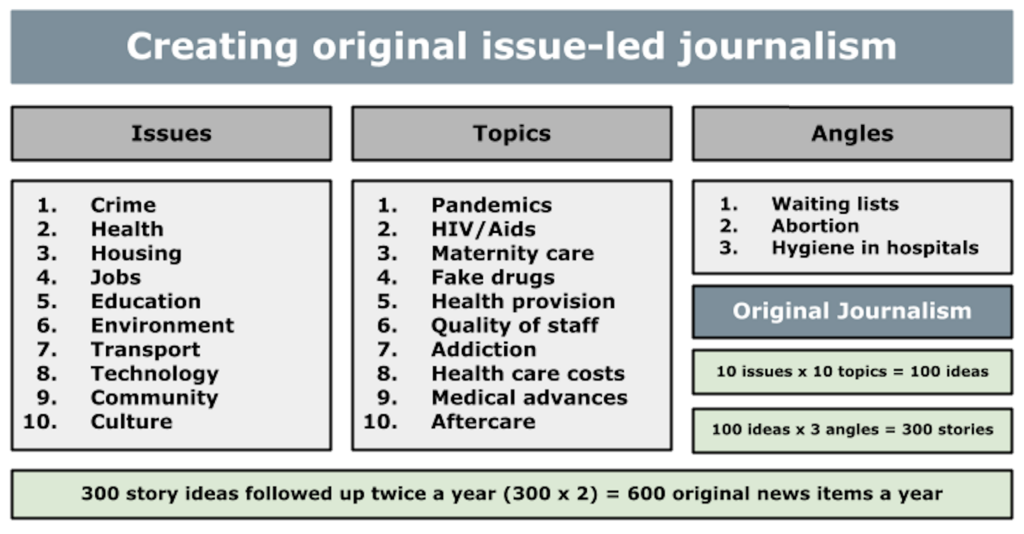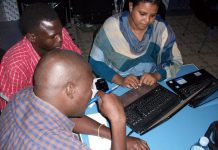
This article sets out the process for producing original, in-depth, issue-led journalism designed to inform the public debate.
In a previous article about Knowing your audience we dealt with the first stage in establishing a strong media business. This second stage deals with producing content aimed at meeting the needs of that target audience group.
Establishing a differential
To survive in a fiercely competitive media world a news organisation must offer something different. There are many demands for the attention of your audience. What you offer has to stand out.
For a broadcaster or publisher with a public service remit the role is to cover the stories that are often ignored by others. This doesn’t mean that your editorial proposition has to be worthy, boring and dull. Just the opposite – these will be stories about the issues that really concern your audience.
These stories will need to be produced in a way that uncovers angles and reveals information that will help your audience better understand the issues that affect them.
Such issue-led journalism is essential for informing the public debate. It’s the opposite of simply repeating the information handed out in news releases, or reporting about official, stage-managed events.
Those stories have to be covered, too, but the role of the journalist is to dig where others don’t and to shine a light in dark places in order to uncover information that, otherwise, might remain hidden.
It means journalists have to set the editorial agenda rather than be led by an agenda set by others – that is the role of the journalist.
But setting the framework for that to happen is the role of the senior management team. This modules looks at how to do that.
Issue-led journalism

Gather your senior management team. Include representatives from editorial, commercial, technical and business development. It will be the same team that helped you identify the target audience in a previous exercise.
In that exercise we looked at the target audience profiles, and tried to imagine the issues that most concerned them. Now we turn to the part of the process where you list those issues.
Wherever this exercise has been carried out, the answers are roughly the same. The issues that most concern the target audience are usually:
- Jobs
- Homes
- Health
- Education
- Crime
- Environment
- Security
- Future
- Technology
- Transport
Your list of 10 issues might be different, but it will probably contain many of the above.
Note that politics and corruption are not listed as main issues, despite being suggested as such almost every time this exercise is carried out. This is because politics and corruption are often common to all issues, rather than being issues or topics in their own right.
Involve your senior editors
So, we have made a start. This list is the beginning of your unique editorial proposition which you will investigate on behalf of your audience. However, at this stage, it all looks a bit dull. These are just words. We need more. So we move onto the next step.
Gather some of your senior editors and invite them to think of 10 topics for each issue. For example, let’s take health. Topics under the issue of health might include the following:
- Hospital waiting lists
- Abortion
- HIV/Aids
- Fake drugs
- Lack of medicines
- TB
- Malaria
- Health education
- Hospital cleanliness
- Quality of medical staff
Ask the editors to write down at least 10 topics for each of the 10 issues. So, we now have 10 issues, multiplied by 10 topics for each issue, which equals 100 ideas. But these are still words on a list. Now comes the fun part.
Involve all your producers and reporters
The editors now hand this list to the reporters and ask them to think of at least three story ideas for each topic. The reporters gather and discuss the ideas, thinking of how to illustrate each issues through examples reflecting the lives of the target audience groups identified earlier.
A reporter might know someone who has had a back-street abortion. They might have heard that hospital waiting lists in their area of the town are lengthy. Perhaps they have heard of someone who has become sick after visiting hospital. Or maybe they could imagine a scenario and then talk to people in the street to see if they know of such an incident and can introduce them to someone who can tell their story.
Let’s take the topic of health education. We might find that the list compiled by the reporters looks something like this:
- Young people unaware of the risks of HIV/Aids
- Stigma preventing people from admitting they are ill
- Illness spread through the poor preparation of food in hospitals
Whatever the story ideas your reporters suggest, at the end of this stage of the exercise you will have three story ideas for each topic. So you now have 10 issues multiplied by 10 topics multiplied by three story ideas, which equals 300 possible stories.
These stories will be timeless, meaning that they are not related to a particular event or announcement. They will have a long shelf life, meaning that they will not go out of date quickly. And, most of all, they will be stories that are unique to your news organisation, and which you are likely to want to return to in the future in order to follow up developments.
You will be producing stories that, had it not been for your news organisation, would never have been told. This is your unique editorial proposition, which is your market differential.
The planning editor
These stories are then managed by the planning editor, who has the responsibility for ensuring that all the story ideas are well planned, produced for multiple devices, and followed up.
S/he will keep a calendar with these stories plotted. Each story will have a follow up date. It might be three months or six months, perhaps even a year. But it is important that each story is revisited to find out what has changed since it was first covered.
Please refer to the article ‘Strategic forward planning for media organisations‘ in which we look more closely at the role of the planning editor.
So we now have 300 story ideas revisited at least once a year, which equals 600 stories. This is about 12 original stories a week. These are stories that your competitors won’t have. They will be forced to follow your lead.
However, by the time they do, you will have published the next set of original stories. They will be forced to follow again.
You will have taken control of the news agenda. This is now the central part of your editorial strategy to provide issue-led journalism that informs the public debate so that your audience can make educated choices.
This is responsible journalism. And it is clever journalism, too, because, if your audience feels you are covering the issues that matter most to them, they are more likely to trust you and continue using your news services. This will increase your opportunities for revenue generation.
Monitoring and saving costs
Now you have the list of issues, topics and stories, share it with your sales and marketing team so that they can build campaigns around the content they know you are planning to produce.
The strategy above also saves resources and costs. You can often cover several well-planned stories in the one trip making sure you get the best value out of your journalists, technical teams and editors.
Becoming a news leader
When I did this with the Serbian broadcaster B92 in Belgrade in 2005, the competition started to ask where they got the news releases from – the competitors were accustomed to having all news delivered via the wires, through news releases, or via organised and stage-managed news conferences.
They found it hard to understand that the stories were produced through the process of issue-led journalism and forward planning, and not as a result of the process of public relations.
Once you have decided to produce issue-led journalism there will be no stopping you. You will be the agenda-setters.
I have carried this exercise out from Azerbaijan to Zimbabwe and the results in all cases have been impressive.








